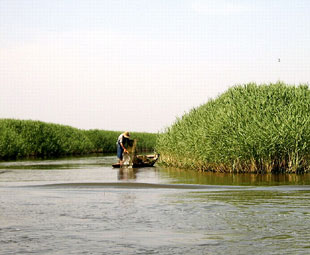China has refilled its largest freshwater lake in the north in a five-month operation with diverted water from the Yellow River, saving the lake from drying out as a result of its headwaters being used for Olympic emergency water supply reservoirs.
A total of 156 million cubic meters of water from the country's second longest river had been injected into the Baiyangdian lake in north China's Hebei Province by early on Friday morning, said the Office of State Flood Control and Drought Relief Headquarters in a press release on Friday.
Stricken by continuous drought, the lake has seen water levels sharply lower over the past few years and has had to give up its nearest water sources to back up Beijing's water use for the coming Games.

After the diversion was completed, the water surface area of the lake more than doubled to 140 from 60 square kilometers, said the office.
"The project is an important part of the work to ensure water supply for the Olympics and protect north China's ecological environment," it said. "It was of political significance."
With the water coming through a 400-meter route from the Huanghan Lock Gate in Liaocheng City, Shandong Province, Baiyangdian saw its water level rise to 7.42 meters from 6.2 meters. The official gauge of dryness for the lake is 6.5 meters.
The lake's water line dropped to 6.32 meters because of scant rain fall last October, causing damage to the local ecological system and affecting 230,000 residents, according to project organizers.
The 148-day project was launched in January, the second such project since November 2006, when the lake was hit by the worst drought in half a decade.
Three of the lake's upstream reservoirs in Baoding City of Hebei -- Wangkuai, Xidayang and Angezhuang -- provide 300 million cubic meters of back-up water for Beijing. Their combined reserves were 467 million cubic meters last winter, according to project engineers.
Baiyangdian, dubbed the "pearl of north China", is the region's largest marsh and essential to local climate adjustment and ecological balance, said the statement.
Baiyangdian is actually a collection of 143 small lakes about 160 kilometers southwest of Beijing. It has relied on reservoir water replenishment since 1992.
(Xinhua News Agency June 21, 2008)